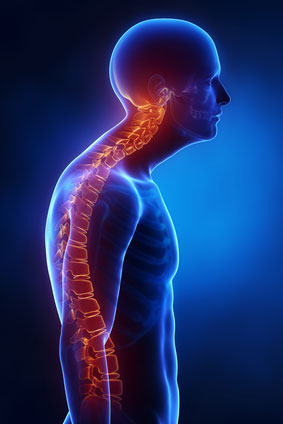Kyphosis: excessive curvature of spine; bowing or rounding of the back, can result in a hunchback posture.

Condition and Causes
When viewed from the side, the spine has some normal, gradual curves. The neck and lumbar sections of the spine have a lordotic curve, which means that they curve inward. The thoracic spine has a kyphotic curve, which means that it curves outward. The curves help to keep the body balanced above the pelvis. Kyphosis occurs when a kyphotic curve is excessive and causes a bowing or rounding of the back, which sometimes results in a slouching or hunchback posture. Severe kyphosis can cause pain and serious problems with organs and tissue.
Degenerative diseases, vertebral compression fractures, or trauma to the spine can cause kyphosis. Infections, paralytic disorders, spina bifida, connective tissue disorders, and tumors can also lead to kyphosis. There are several different types of kyphosis, the most common of which is Postural kyphosis. Postural kyphosis occurs when poor posture or slouching stretches ligaments in the spine, leading to abnormal vertebral formation. It creates a smooth curve that is not usually painful or problematic. This type of kyphosis is most commonly found in adolescent girls.
Another type of kyphosis is Scheueremann's Disease, in which vertebral wedging and reduced intervertebral disc space cause a stiff curve to form in the upper-middle spine. Scheueremann's Disease is more prevalent in boys and usually begins between 12-15 years of age. It may cause back pain, and some with this disease may also have mild scoliosis.
Congenital kyphosis occurs when the spinal column is irregularly formed during fetal development. Bones may be malformed or vertebrae may be fused together, and the condition may worsen as the child ages. In some cases, congenital kyphosis can lead to lower body paralysis.
Symptoms and Diagnosis
Symptoms of kyphosis include rounded back posture, tenderness or stiffness of the spine, fatigue and mild back pain. In severe cases, a patient may have difficulty breathing.
In order to diagnose kyphosis, a physician will go over the history of a patient's condition and follow with a physical exam. A forward bend test may be used to observe and confirm the presence of abnormal spine curvature. In order to determine if the excessive curve is caused by bad posture, the physician may ask the patient to lie flat. If there is no deformity when the patient lies on his or her back, the kyphosis is caused by poor posture. If the curve is still present, the kyphosis is caused by structural problems in the spine.
The physician will also test for signs of weakness or changes in sensation below the curve to determine if any changes have taken place in the nervous system.
To confirm the diagnosis, the doctor will take an X-ray to determine the degree of the curve and to find out if there is any vertebral deformity, which can help to identify the type of kyphosis.
Treatment
Treatment for kyphosis ranges depending on the severity and cause of the curve. Other considerations include progression and the age of the patient. Nonsurgical treatments include observation, physical therapy and bracing. Surgery may be needed if the curve is particularly extreme, or if nonsurgical treatments have failed to have an affect on the curve or symptoms after a certain period of time.
